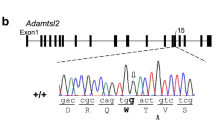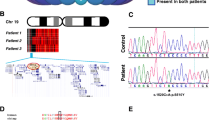Abstract
THE Abdominal B (AbdB) genes constitute a distinct subfamily of homeobox genes that exhibit posterior domains of expression1,2, including the genital imaginal disc in Drosophila and the develop-ing urogenital system in vertebrates3,4. We have mutated the AbdB gene Hoxal0 in mice. We report here that homozygotes are fully viable and show an anterior homeotic transformation of lumbar vertebrae. All male homozygotes manifest bilateral cryptorchidism resulting in severe defects in spermatogenesis and increasing steril-ity with age. Female homozygotes ovulate normally, but about 80% are sterile because of death of embryos between days 2.5 and 3.5 post coitum. This coincides spatially and temporally with expression of maternal Hoxal0 in distal oviductal and uterine epithelium. These results indicate a role for AbdB Hox genes in male and female fertility and suggest that maternal Hoxal0 is required to regulate the expression of a factor that affects the viability of preimplantation embryos.
Similar content being viewed by others
References
Izpisúa-Belmonte, J. C., Falkenstein, H., Dollé, P., Renucci, A. & Duboule, D. EMBO J. 10, 2279–2289 (1991).
Krumlauf, R. Cell 78, 191–201 (1994).
Celnicker, S. & Lewis, E. B. Genes Dev. 1, 111–123 (1987).
Dollé, P., Izpisúa-Belmonte, Tickle, C. & Duboule, D. Genes Dev. 5, 1767–1776 (1991).
Lyon, M. & Hawkes, S. Nature 227, 1217–1219 (1970).
Radovick, S. et al. Proc. natn. Acad. Sci. U.S.A. 88, 3402–3406 (1991).
Wensing, C. J. G. Horm. Res. 30, 144–152 (1988).
Kaufman, M. H. The Atlas of Mouse Development (Academic, San Diego, 1992).
Park, W.-H. & Hutson, J. J. Ped. Surg. 26, 615–617 (1991).
Wells, L. J. Anat. Rec. 88, 465 (1944).
Bowman, P. & McLaren, A. J. Embryol. exp. Morphol. 24, 203–207 (1970).
Erbach, G., Lawitts, J., Papaioannou, V. & Biggers, J. Biol. Reprod. 50, 1027–1033 (1994).
Sakkas, D. & Trounson, A. O. J. reprod. Fert. 90, 109–118 (1990).
Benson, G. V., Nguyen, T.-H. E. & Maas, R. L. Molec. cell. Biol. 15, 1591–1601 (1995).
Brown, J. & Whittingham, D. Development 112, 99–105 (1991).
Schultz, G. & Heyner, S. Oxford Rev. reprod. Biol. 15, 43–81 (1993).
Adamson, E. D. J. Cell Biochem. 53, 280–287 (1993).
Pollard, J., Pampfer, S., Daiter, E. & Arcecci, R. in Uterine and Embryonic Factors in Early Pregnancy (eds Strauss, J. & Lyttle, R. C.) 109 (Plenum, New York, 1991).
Hogan, B., Costantini, F. & Lacy, E. in Manipulating the Mouse Embryo 89–94 (Cold Spring Harbor Laboratory Press, New York, 1986).
Satokata, I. & Maas, R. Nature Genet. 6, 348–356 (1994).
Li, E., Bestor, T. & Jaenisch, R. Cell 69, 915–926 (1992).
Bradley, A. in Teratocarcinomas and Embryonic Stem Cells, a Practical Approach (ed. Robertson, E. J.) 113–151 (IRL, Oxford, 1987).
Sassoon, D. & Rosenthal, N. Meth. Ezym. 225, 384–404 (1993).
Shen, M. & Leder, P. Proc. natn. Acad. Sci. U.S.A. 89, 8240–8244 (1992).
Author information
Authors and Affiliations
Rights and permissions
About this article
Cite this article
Satokata, I., Benson, G. & Maas, R. Sexually dimorphic sterility phenotypes in HoxalO-deficient mice. Nature 374, 460–463 (1995). https://doi.org/10.1038/374460a0
Received:
Accepted:
Issue Date:
DOI: https://doi.org/10.1038/374460a0
- Springer Nature Limited
This article is cited by
-
Cysteine dioxygenase and taurine are essential for embryo implantation by involving in E2-ERα and P4-PR signaling in mouse
Journal of Animal Science and Biotechnology (2023)
-
Calcium sensing and signaling are impaired in the lumbar spine of a rat model of congenital kyphosis
European Spine Journal (2023)
-
MiRNAs secreted by human blastocysts could be potential gene expression regulators during implantation
Molecular Biology Reports (2023)
-
Gonadotropin-releasing hormone agonist downregulation combined with hormone replacement therapy improves the reproductive outcome in frozen–thawed embryo transfer cycles for patients of advanced reproductive age with idiopathic recurrent implantation failure
Reproductive Biology and Endocrinology (2022)
-
Conventional GnRH antagonist protocols versus long GnRH agonist protocol in IVF/ICSI cycles of polycystic ovary syndrome women: a systematic review and meta-analysis
Scientific Reports (2022)





